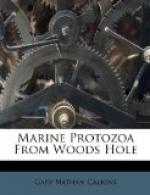Body colorless, elongate, and with the general form of a cucumber, the posterior end being somewhat pointed. The mouth and relatively small peristome are situated in the lower third of the body. The peristome begins as a shallow furrow at the center of the ventral surface and dips sharply into the buccal depression, which is deep and turned toward the posterior end. The left edge of the peristome bears a high undulating membrane, which extends anteriorly only as far as the center of the body; posteriorly it passes around to the right edge of the peristome, thus forming the characteristic membranous pocket. Inside the oral depression is a second undulating membrane, running down to the mouth. This is small and without an oesophagus. The body is clothed with long setose cilia which are frequently fully outstretched when the animal is resting, a slight tremor of the large membrane alone indicating vitality. Posteriorly these appendages are drawn out into long filiform setae, the number varying in different individuals from three to nine or ten. These are extremely fine and difficult to see without a high power (e.g. 1/12 oil) and careful focussing of the substage condensor. Like P. chrysalis, the resting periods are terminated by sudden springs, otherwise the movements are steady and forward. The macronucleus is central, and the contractile vacuole posterior and terminal. Length 45 mu to 50 mu; greatest diameter 17 mu. In decaying algae.
It was this form, I believe, that Peck ’95 described as a “ciliate.”
[Illustration: Fig. 41.—Pleuronema setigera.]
Genus LEMBUS Cohn ’66.
(Cohn ’66; Quennerstedt ’69; Kent ’81;
Fabre-Domergue ’85; Gourret &
Roeser ’88; Buetschli ’88; Shevyakov ’96.)
Free-swimming animals of elongate form, more or less elastic, and flexible, bending readily to avoid obstacles, etc. The anterior half is usually drawn out into a slightly curved neck-like portion. The peristome is a small groove leading from the anterior end to the mouth about midway down the ventral side of the body. Buetschli, following Quennerstedt, describes an undulating membrane on each side of the peristome groove. Other observers, however, usually describe but one, the left, which is clearly defined and stretches out some distance from the body, while the right border is described as having smaller but very active cilia. The general body surface is clothed with fine, uniform cilia, and body striae are usually absent. One or more caudal bristles may be present. The contractile vacuole is posterior and terminal, and may be multiple. The macronucleus is spherical and perhaps double (Kent). Food is chiefly bacteria, and the animals are frequently found with the anterior end embedded in zoogloea masses. Salt water, usually in infusions.
Lembus infusionum, n. sp. Fig. 42.




